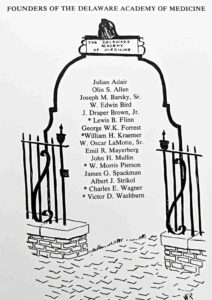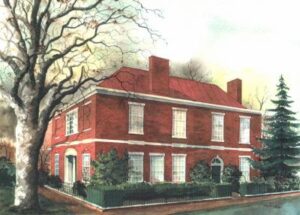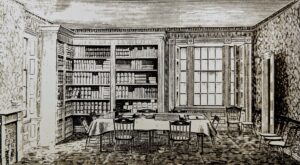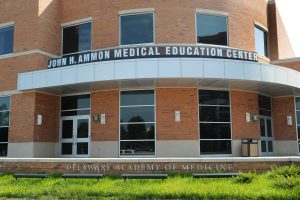
FOUNDING THE ACADEMY
In 1929, the Medical Society of Delaware, the second oldest of its kind in the United States, turned 140. There were 280 practicing physicians and 102 dentists serving the state’s 238,380 citizens. Wilmington alone had four hospitals. Yet, there was little collaboration. The Wilmington hospitals were barely on speaking terms, let alone communicating with the hospitals or doctors in the southern counties. Physicians and dentists had few professional opportunities for cooperation. Likewise, there was no common ground for lectures, symposia, conferences, or other meetings.
Healthcare, more than any other profession, undergoes constant change. The rapid progress of science necessitates a continuous revision of the methods and techniques to maintain or restore human health. Practitioners of medicine must stay informed of new developments to offer the best possible care to patients. Weekly and monthly periodicals recorded advances, but no single physician could afford to subscribe to the ever-increasing literature volume before the digital age. Scientific libraries and reading rooms were essential. However, in the 1920s, the closest medical libraries were in Baltimore and Philadelphia.
On December 12, 1929, sixteen Delaware doctors met to discuss creating a neutral forum for collaboration and education across specialties or hospital affiliations. This coalition had representatives from the four Wilmington hospitals and included internal medicine, obstetrics-gynecology, surgery, and dentistry specialists. The group often met to figure out how to house and fund their idea. In February 1930, more than fifty Delaware physicians and dentists approved a resolution to form the Delaware Academy of Medicine. The Medical Society of Delaware officially endorsed the incorporation.
The mission of the new Academy was to provide a professional library and a meeting place where doctors and dentists from all over the state could gather to exchange ideas and experiences and so improve the quality and delivery of medical care. They also created the Academy to be a historical repository for the Delaware medical community, documenting and memorializing the lives of its members. Dr. Flinn served as the Academy’s first president, occupying the office for twelve years.

The Delaware Academy of Medicine’s first home was Wilmington’s former Bank of Delaware building that initially stood on Sixth and Market Streets. When the bank moved to newer quarters in 1931 and the historic 1815 building was left empty, Mrs. Henry B. Thompson and Mrs. Ernest I. duPont led a drive to raise funds to purchase the building for the newly founded Academy. With their help and support, the building was relocated to the current site on Lovering Avenue, and the Academy took up residence there in 1932. In 1958, an addition was constructed, expanding the auditorium and creating more office space for the various medical groups that had their offices in the building.

SERVING THE COMMUNITY
For decades, the Lovering Avenue building was home to the Academy and served as Delaware’s institutionally neutral medical education center. In 1961, the Academy established the Student Financial Aid program. Since then, nearly 1,200 students of medicine and dentistry have received more than $1.85 million in loans.
The Lewis B. Flinn Library (named in 1984) provided research assistance and library services in-house and externally with the Circuit Riding Library Program and the Gail P. Gill Consumer Health Library. In 1982, the Circuit Riding Medical Library Program, which regularly brought library services to health care institutions, was established with the first contracts at Kent General and Milford Memorial hospitals. That program was discontinued in 2007 when the last of those libraries began running an in-house library.
The Academy was also home to Tel Med. This public medical phone service provided round-the-clock information on hundreds of medical and dental topics such as HIV-AIDS, allergies, pregnancy, and suicide. In 1991, the program became completely computerized to handle the nearly 6,000 monthly calls.
WILMINGTON MEDICAL CENTER
Dr. Norman L. Cannon, urologist and former president of the Academy, was among the first to suggest a merger of Wilmington’s three major hospitals. In 1961, he published his influential article titled “The Case for a Hospital Merger” in the Delaware Medical Journal. The idea took hold quickly. New medical technologies and a rapidly growing population strained the resources of individual hospitals. Merging the Delaware, Memorial, and Wilmington General Hospitals would create a unified hospital system with more than 1,000 beds to offer better patient care and teaching programs. In 1965, the three hospitals became “divisions” and merged to become the Wilmington Medical Center. Within five years, it was clear that the Center would need to expand even more to keep up with the needs of Delawareans.
CHRISTIANA CARE
In 1981 construction began on a new 780-bed hospital near Christiana, Delaware. Two of the three hospitals comprising the Wilmington Medical Center were razed, and Wilmington Hospital was renovated. Christiana Hosptial opened in 1985. In the 1990s, Christiana Hospital became ChristianaCare Health Systems (later ChristianaCare). The epicenter of medicine and medical education had shifted from the Academy to the Christiana campus by this time.
The Academy needed to evolve to continue to serve its community.
STRONGER TOGETHER
In 1999, ChristianaCare and the Delaware Academy of Medicine boards formed a unique strategic alliance to better serve their missions and communities. Together with CCHS, the Academy hosts many educational programs, including the Mini-Med School, the Global Health Lecture Series, and conferences.
In 2006, the Academy moved to a new home on the ground floor of the John H. Ammon Medical Education Center.
The Delaware Academy of Medicine is located as a tenant at ChristianaCare, though it is important to note the Academy is not a part of ChristianaCare. Even with this close affiliation, the Academy remains, as always, an institutionally neutral home for healthcare professionals. The Academy maintains programmatic relationships with all other hospitals, specialty societies, and the Division of State government, including the Division of Libraries and the Division of Public Health. The Academy continues to work with hospitals, specialty societies, and the Delaware Divisions of Public Health and Libraries throughout the state.
WHERE’S THE LIBRARY?
Rather than duplicate services and subscriptions, the Lewis B. Flinn Medical Library was merged with the ChristianaCare Library when the Academy moved to the Ammon Center. In 2016, the Gail P. Gill Consumer Health Library was added as well. The Lewis B. Flinn medical library, located on the first floor of the Education Center, is a merger of the original Delaware Academy of Medicine and Christiana Hospital libraries.
In 1993, the leadership of the Academy created the Delaware Academy of Medicine Historical Archives. This subset of the Academy strives to preserve and share the rich history of medicine and public health in Delaware. The Archives remains an active part of the Academy. Historical object collections are on display and open to the public in the Academy’s Suite L10 and on the first floor of the Ammon Center. The manuscript collection and rare book library are available to researchers by appointment.
WHAT IS THE DAM/DPHA?
Recognizing the Academy’s new role as an essential public health resource within the state, the American Public Health Association (AHPA) officially transferred the Delaware Public Health Association (DPHA) affiliation to the Delaware Academy of Medicine in 2013.
Together the Academy/DPHA promotes and advocates for improving the health and welfare of all Delawareans. The Delaware Academy of Medicine/Delaware Public Health Association (Academy/DPHA) advocates for public health in many forms:
IMMUNIZATION COALITION: A partnership with the Delaware Division of Public Health to increase immunization coverage in the First State.
PLAN4HEALTH: Working with the Delaware Chapter of the American Planning Association to incorporate health into the comprehensive plans for Kent County and Dover.
TOBACCO21: With the Delaware Chapters of the American Heart Association and the American Lung Association, DAM/DPHA successfully increased the legal age to buy tobacco products in Delaware to 21.
Working with Environmental Advocates, HB 309 (prohibiting vaping indoors) and HB 456 (prohibiting lead paint on outdoor structures) were signed into law.
The DELAWARE JOURNAL OF PUBLIC HEALTH (DJPH) is the signature peer-reviewed journal of the Academy/DPHA. It focuses on Delaware’s public and population health programs, practices, and policies and how they affect citizens and practitioners in the state. This electronic-only publication is published five times per year. Unlike a hardcopy edition, the DJPH can connect directly to other resources, studies, and events. This model is in keeping with patterns of access by our readership, is eco-friendly, and respects limited resources. All issues and content of the DJPH are open to access from the publish date at DJPH.org.
The partnership has proven successful; the APHA presented the Academy/DPHA with the 2020 Outstanding Affiliate of the Year Award.
